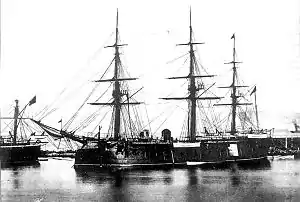Italian ironclad Venezia
Venezia was the second of two Roma-class ironclad warships built for the Italian Regia Marina in the 1860s. She was armed with a main battery of eighteen 10-inch (250 mm) guns in a central armored casemate. Her lengthy construction time, a result of her re-design from a broadside ironclad, quickly rendered her obsolescent compared to the new turret ships that began to enter service in the 1880s. As a result, her career was limited. She became a training ship in 1881 and served until 1895. Venezia was broken up for scrap the next year.
 Venezia at anchor in 1876 | |
| History | |
|---|---|
| Name: | Venezia |
| Namesake: | Venice |
| Laid down: | February 1863 |
| Launched: | 21 January 1869 |
| Completed: | 1 April 1873 |
| Stricken: | 1895 |
| Fate: | Scrapped, 1895–1896 |
| General characteristics | |
| Class and type: | Roma-class ironclad warship |
| Displacement: | |
| Length: | 79.65 m (261 ft 4 in) |
| Beam: | 17.48 m (57 ft 4 in) |
| Draft: | 7.6 m (24 ft 11 in) |
| Installed power: |
|
| Propulsion: | One single-expansion steam engines |
| Speed: | 13 knots (24 km/h; 15 mph) |
| Range: | 1,940 nmi (3,590 km) at 10 kn (19 km/h; 12 mph) |
| Complement: | 549–551 |
| Armament: | 18 × 10 in (254 mm) guns |
| Armor: |
|
Design
Venezia was 79.65 meters (261.3 ft) long between perpendiculars; she had a beam of 17.48 m (57.3 ft) and an average draft of 7.6 m (25 ft). She displaced 5,722 long tons (5,814 t) normally and up to 6,151 long tons (6,250 t) at full load. Her propulsion system consisted of one single-expansion steam engine that drove a single screw propeller, with steam supplied by six coal-fired, cylindrical fire-tube boilers. Her engine produced a top speed of 13 knots (24 km/h; 15 mph) from 3,670 indicated horsepower (2,740 kW). She could steam for 1,940 nautical miles (3,590 km; 2,230 mi) at a speed of 10 knots (19 km/h; 12 mph). The ship was barque-rigged to supplement the steam engine. She had a crew of 549–551 officers and men.[1]
Venezia was designed as a broadside ironclad, but other navies had developed the central battery ship while she was under construction, prompting the Italian Navy to re-design the ship.[2] She was armed with a main battery of eighteen 10 in (254 mm) guns placed in a central casemate. The central battery design allowed two guns to fire ahead and two to fire astern. The ship was protected by iron belt armor that was 5.9 in (150 mm) thick and extended for the entire length of the hull at the waterline. The casemate was protected with 4.75 in (121 mm) of iron plating.[1]
Service history
Venezia's keel was laid down at the Cantiere della Foce shipyard in Genoa in February 1863, and her completed hull was launched on 21 January 1869. Fitting-out work was completed on 1 April 1873; the re-design work significantly delayed completion compared to her sister, which had been finished almost four years before.[1] Despite being completed as a central battery ship, Venezia nevertheless rapidly became obsolescent, as the type was superseded by new turret ships like the Caio Duilio class begun the same year she entered service.[2] In addition, the Italian naval budget was drastically reduced following the defeat at Lissa in 1866, which reflected a stark decrease in the government's confidence in the fleet. As a result, she saw little use during her career.[3][4]
Venzia was converted into a torpedo training ship in 1881; her sailing rig was cut down and she was equipped with four 75 mm (3.0 in) guns and four 57 mm (2.2 in) guns. Her crew was significantly reduced to 302 officers and men. She served in this capacity until 23 August 1895 in La Spezia. The ship was stricken that year and had been broken up by 1896.[1]
Notes
- Gardiner, p. 339
- Sondhaus (2001), p. 112
- Ordovini et al., p. 348
- Sondhaus (1994), pp. 49–50
References
- Gardiner, Robert, ed. (1979). Conway's All the World's Fighting Ships: 1860–1905. London: Conway Maritime Press. ISBN 0-85177-133-5.
- Ordovini, Aldo F.; Petronio, Fulvio & Sullivan, David M. (December 2014). "Capital Ships of the Royal Italian Navy, 1860–1918: Part I: The Formidabile, Principe di Carignano, Re d'Italia, Regina Maria Pia, Affondatore, Roma and Principe Amedeo Classes". Warship International. Vol. 51 no. 4. pp. 323–360. ISSN 0043-0374.
- Sondhaus, Lawrence (1994). The Naval Policy of Austria-Hungary, 1867–1918. West Lafayette: Purdue University Press. ISBN 9781557530349.
- Sondhaus, Lawrence (2001). Naval Warfare, 1815–1914. New York: Routledge. ISBN 0-415-21478-5.